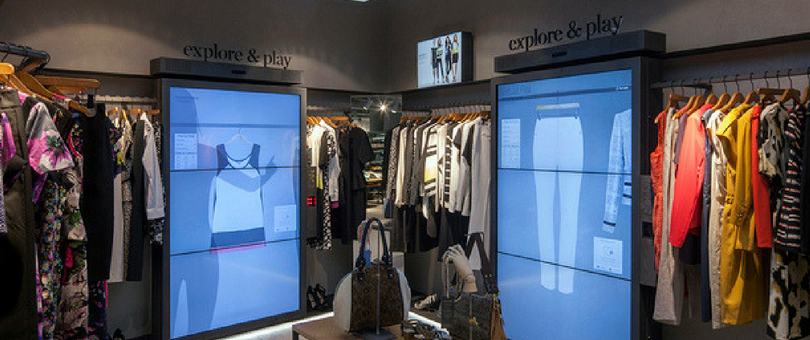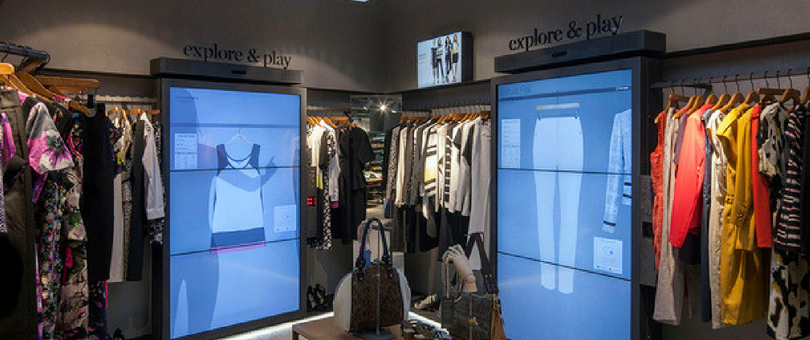
There has been a lot of focus in the retail industry lately aimed at finding new ways to connect with consumers in-store and differentiate the brick-and-mortar experience from ecommerce.
Many retailers are working to create a distinct in-store experience — but in today’s connected world, the most successful retailers are fusing digital and physical shopping to create a cohesive multichannel experience.
One of the ways retailers have drawn the digital experience into brick-and-mortar stores is through digital signage. Digital signage is exactly what it sounds like: signs and screens you can use throughout your retail store that display digital ads, videos, traditional store signage, or any other message you want to relay to customers.
Digital signage and corresponding digital signage software open up a myriad of new options for your store displays and it can make a real difference for customers. In fact, 68% of customers note that digital signage would make them more likely to buy advertised products. Forty-four percent even stated it would influence them to buy the advertised product instead of a product they already planned to purchase.
That’s why some retailers are rapidly taking to digital signage — and it seems to be working. When Nielsen tracked 120 grocers who use digital signage in their stores, they found that 80% of them saw as much as a 33% boost in sales (compared to using print signs.)
So, to answer our first question: Yes, digital signage can be worth the investment. Now, let’s talk about how you can leverage digital signage in your store.
How Can Retailers Use Digital Signage?
Digital signage is a broad category of displays and signs, so there’s no end to the different ways you can use it in your store.
Digital signs can do so much more than traditional printed store signage. They can be interactive, boosting customer engagement. You control every sign throughout your store in one place, so they’re always accurate and updated. Because they’re so easy to program and change, digital signs open the door to more timely and seasonal store displays.
Services like Look Digital Signage provide simple and reliable software solution for remote management of digital screens networks of various scales and purposes, like, ad screens in retail stores or digital menu boards in restaurants. It allows to manage all the media content, been it audio, video, dynamic streams or interactive scenarios in an unlimited number of locations at any time and from anywhere.
Here are a few of the ways you can use the increased capability of digital signs to boost your customer experience and grow your bottom line.
FURTHER READING: Want to know more about the different kinds of signage retailers need in-store? Read up on the five types of signage no retailer can afford to ignore.
Draw in Window Shoppers and Boost Foot Traffic
The benefits of digital signage begin before customers even set foot in your store. Digital signage can help you to create more powerful and engaging window displays.
For example, you can use digital signage software to update window displays to reflect whatever focus or sales are happening in-store.
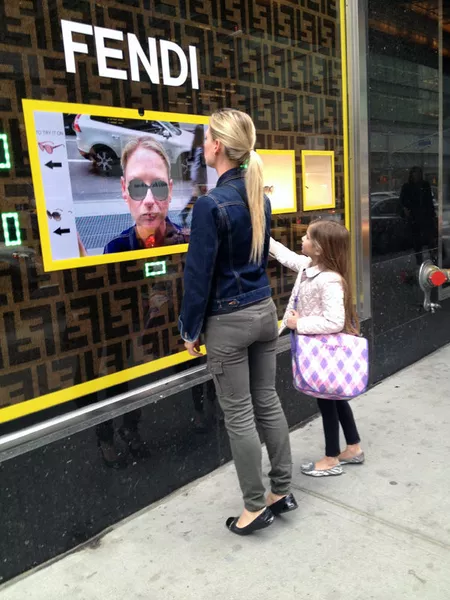
But one of the biggest benefits of digital signage in the window is movement. Because digital signs can move and change, they’re way more likely to catch the eye of shoppers and passersby. Printed signs only capture shopper interest for as long as it takes to read them. When signs change and move, you can draw shoppers in, both visually and physically. That means you’ve piqued their interest and you have a literal foot in the door.
FURTHER READING: Learn more tips to accurately measure and boost your store’s foot traffic.
Tell Your Brand’s Story
With printed signage, you’re limited by space. Even if you wallpaper the entire store in signs, you still only have so much space. Digital signage erases those limits. That means you can do more with your store’s signage than just label different displays. You can better tell your brand’s story.
Today’s most successful retailers have become more than just a store to consumers. Retailers like Toms and Ben & Jerry’s are known more for their brands than their products. It’s your story that draws customers in and keeps them coming back. Digital signage frees up the square footage to tell that story right in your store, and offer you a high-tech, visual way to relay your brand story to shoppers.
Pop-in stores are another use case for digital signage. When your square footage is really limited (because you’re in someone else’s retail space), they can help draw customer attention to your products and displays with messaging that’s simple to change.
Share Product Information and Upsell
You have floor staff who can answer customer questions about any product in the store. But isn’t their time better spent encouraging sales than answering the same questions — about product features and benefits — over and over?
With digital signage, you have the real estate to display more product information for customers to reference. You can also engage customers with interactive displays that give them the information they’re looking for, freeing up floor staff to use their time more productively. You can even offer robust product comparisons, making it easier for customers to make a buying decision.
Speaking of productive time, digital signage enables you to boost sales through upselling and cross-selling — without having to double your staff. You can program digital displays to offer recommendations and promote add-on items and packages. That means you can have five digital stations throughout the store that are working to grow your store’s revenue, even if you only have two sales associates on the floor.
Bring Your Online Efforts In-Store
As I mentioned earlier, many retailers are working to differentiate the ecommerce and brick-and-mortar experiences. We’ve seen that competing with ecommerce on factors like ease and convenience isn’t a winning strategy for retail, but with tools like digital signage, it doesn’t have to be one sales channel over another.
Stores that sell online put a lot of effort into digital marketing — and rightfully so. Digital signage empowers your physical store to benefit from those efforts, too. You can pull in valuable social proof (like social media posts from customers and online reviews) and repurpose strong online content for viewing in your shop.
3 Creative Examples of Digital Signage
Digital signage is far from a lofty concept. Many larger retailers are already finding creative new ways to leverage it in their stores. That means there are plenty of innovative use cases you can learn and draw inspiration from.
Let’s look at a few from Nordstrom, Sephora, and Rebecca Minkoff.
Nordstrom Takes the Frustration Out of Shopping
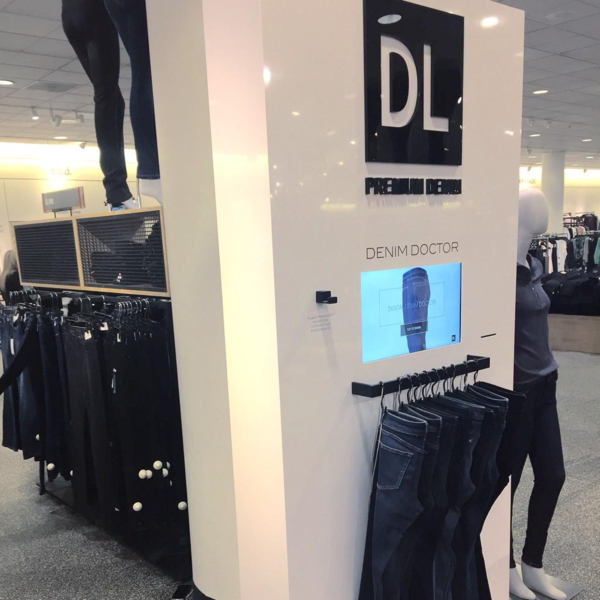
No matter your size, age, or gender, we all have one thing in common: we hate shopping for jeans. From radically different sizing across brands to dozens of fit and style options, denim is one of those frustrating shopping experiences.
But Nordstrom is using digital signage to make shopping for jeans a lot less frustrating. Their “Digital Denim Doctor” display uses 360-degree imagery and intelligent programming and filters to give shoppers a clear path through the miles of denim and stitching. The doc recommends the best jeans for your body type, lifestyle, and fabric preferences so you don’t need to wander aimlessly through endless racks of denim.
Sephora Lets Customers Try Before They Buy
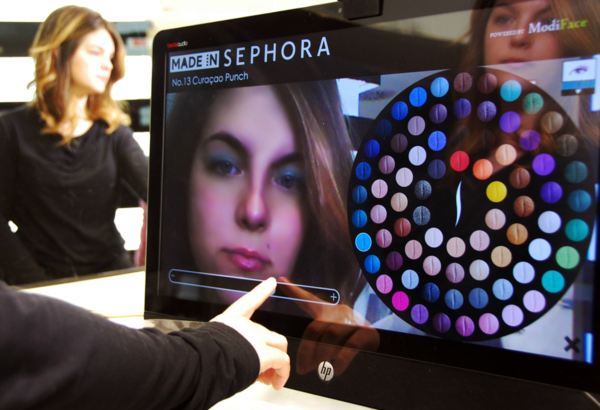
Makeup and skincare is one category of product you always want to try out before you buy. That’s tough for customers and retailers who have to find a balance between customer desires and inventory realities. The common department store makeover option carries its own risks, too.
Sephora listened to their customers and created the ModiFace digital display. Customers can virtually try on Sephora products without having to carry makeup remover wipes. The ModiFace technology means Sephora sees fewer product returns and exchanges, and it can help draw attention to Sephora’s pop-in stores within larger retail spaces.
Rebecca Minkoff Dresses Up the Dressing Room
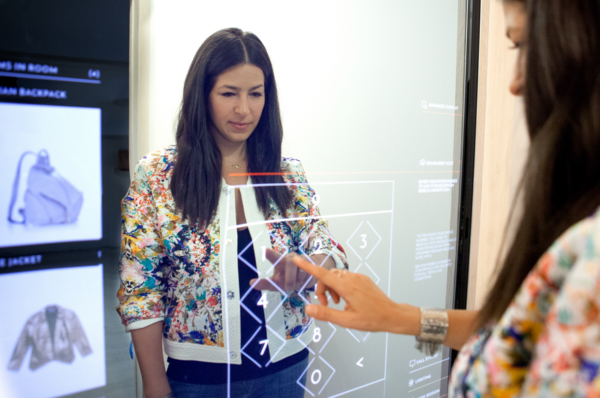
The fitting room experience in most retailers today leaves a lot to be desired. That’s why Rebecca Minkoff stores are changing it up completely with “smart” mirrors.
They’ve combined the best of ecommerce and brick-and-mortar retail to bring an entire catalog into the dressing room. Shoppers can “order” additional clothes or sizes to the fitting room. You can even adjust the ambient lighting in the room to make extra sure you like (or don’t like) what you’re trying on.
Buying Digital Signage
With all the benefits and innovative uses of digital signage, you might be more than ready to try out this technology. So, how can you get your hands on some digital signage and displays for your retail store?
Before you whip out your wallet, you want to ensure you’re investing in the best technology and digital signage software, both in general and for your store in particular. Here are a few questions to ask before you buy:
- What industry is the system designed for? Digital signage is used across several industries, from education to human resources. Look for a digital signage system that’s designed for retail stores specifically, so you can be sure it has the right capabilities to make a difference for you.
- Does it support customer engagement and interactivity? Many of the most effective uses of digital signage for retail involve customers interacting with the display. That means, to get the most out of digital signage, you need a solution that supports engagement and interactivity.
- Is it scalable? Whether you expect your retail business to grow a little or a lot (or you just expect your digital signage usage to grow), the last thing you want is to have to change systems to do it. You want to invest in a solution that can grow with you and your store.
For more context around digital signage software and the options available to you, check out this discussion on Quora.
Bring Digital Signage Into Your Store
Bringing digital signage into your store opens up a whole world of new possibilities for promoting products, serving customers, and generally enhancing the store experience. That’s why digital signage installations are growing by nearly 40% year over year, with retail leading the industry at 25% of sales.
However you decide to use them, digital signs and displays can make a big difference for your store and your customers — and that’s worth investing in!

